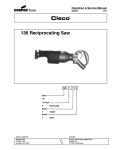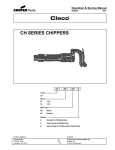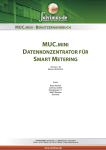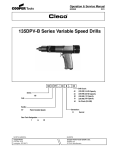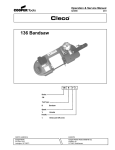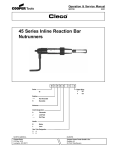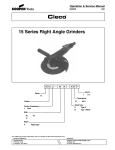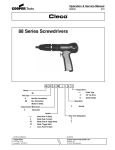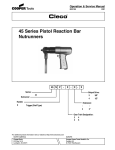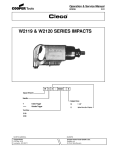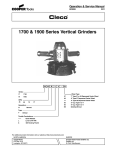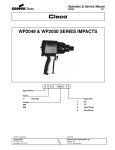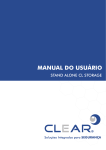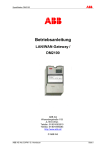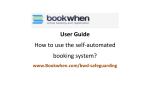Download warning - Apex Power Tools
Transcript
Operation & Service Manual 823046 7/01 E SERIES RIVETERS 16 SERIES CHIPPERS XX - XXX - XX - X Series: E2 E3 E4 (2 1/4 Stroke) (3" Stroke) (4" Stroke) E5 16 (5" Stroke) (1 7/16 Stroke) Handle Style: AJ Lever BWD Offset Nose Type : RD Round HX Hexagon RT Round Taper Retainer : B Beehive O Open Coil NORTH AMERICA EUROPE CooperTools P.O. Box 1410 Lexington, SC 29071 Cooper Power Tools GmbH & Co. Postfach 30 D-73461 Westhausen 1 Safety Recommendations For your safety and the safety of others, read and understand the safety recommendations before operating any percussion tool. Always wear protective equipment and clothing. Caution: Faceshields do not provide unlimited proImpact resistant eye protection must be worn while operating t e c t i o n or working near this tool. against flying particles and are not to be considered as eye protection. ANSI Z87.1 states that separate eyewear shall be used. For additional information on eye protection, refer to Federal OSHA Regulations, 29 CFR, Section 1910.133, Eye and Face Protection, and ANSI Z87.1, Occupational and Educational Eye and Face Protection. This standard is available from the American National Standards Institute, Inc., 11 West 42nd street, New York, NY 10036. ! WARNING the tool is highly recommended. Before the tool is connected to the air supply, check the throttle for proper operation (i.e., throttle moves freely and returns to closed position). Being careful not to endanger adjacent personnel, clear the air hose of accumulated dust and moisture. Attachment of a quickdisconnect air coupling directly to the inlet threads of a percussion tool can cause wear and failure of the coupling. Should the coupling fail, severe injury can result from the hose end violently whipping about. If a quick-disconnect air coupling is used, separate the coupling from the tool with a whip hose (1.5 feet minimum). Only use a whip hose with fittings of hardened steel or other material which is at least comparably resistant to shock. Do not use hose to lift or lower tool. Whip Hose Coupling Nipple Hearing protection is rec! CAUTION ommended Personal hearing protection is in high noise recommended when operating areas (above or working near this tool. 85 dBA). Close proximity of additional tools, reflective surfaces, process noises, and resonant structures can substantially contribute to the sound level experienced by the operator. Proper hearing conservation measures, including annual audiograms and training in the use and fit of hearing protection devices may be necessary. For additional information on hearing protection, refer to Federal OSHA Regulations, 29 CFR, Section 1910.95, Occupational Noise Exposure, and American National Standards Institute, ANSI S12.6, Hearing Protectors. Gloves and other protective clothing should be worn as required. Properly fitted gloves cushion vibration and protect the fingers from pinching, scuffing and scraping and must be used when guiding the chisel on a workpiece. ! WARNING Compressed air hazard. Compressed air can cause loss of eyesight, bleeding or injection of foreign material into the body or blood. Never use compressed air to clean off clothing or direct it at any person. Cleco percussion tools are designed to operate on 90 psig (6.2 bar) maximum air pressure. Excessive air pressure can damage the plunger and increases sound levels. Installation of a filter-regulator-lubricator in the air supply line ahead of 2 Quick Disconnect Coupling Coupling Nipple OK Do not use! Quick Disconnect Coupling Cracked chisels or implements are hazardous. Visually inspect the chisel or implement for cracks before use. Make a practice of having all chisels magnifluxed before resharpening. Destroy and discard any chisel or implement that shows a crack. ! WARNING ! WARNING Explosive Hazard. Do not use this tool in explosive or flammable environment. Correct selection of the chisel or other implement is important. Dull edges on the chisel or moil point cause the energy of the percussion blow to be absorbed by the tool itself, instead of the workpiece, increasing the chance of chisel breakage. When operating percussion tools in explosive or flammable environments, use only non-sparking chisels or implements such as those made from beryllium copper. Also, do not use cupped rivet sets with Cleco percussion tools to drive nails. Blows not centered on the nail can cause the nail to ricochet off the work and strike the user. Safety Recommendations ! WARNING Impact Hazard. Ejected chisels can cause serious injury or even death. Disconnect air before changing chisels. Do not operate unless chisel is in contact with workpiece. Do not point tool in direction of any person. Use safety retainers on tool and retainer type chisels. Erect barriers to protect persons in surrounding or lower work areas. Before removing a tool from service, after completing a job, or changing chisels or other bits, make sure the air line is shut off and drained of air. This will prevent the tool from operating if the throttle is accidently engaged. Use of a self-relieving valve within reach of the user of the tool is highly recommended. INDIVIDUAL WORK STATION Self-Relieving Valve Regulator Lubricator 0 45 90 Coupling Filter Hose Quick Disconnect Coupling Tool Do not operate or trigger any percussion tool unless the chisel, scaling tool, rivet set, or other implement is in the tool and in contact with the workpiece or worksurface. Never point any percussion tool in the direction of another person or yourself, or deliberately eject a chisel. Failure to do so can cause serious injury and/or damage the tool. ! WARNING Chisel or rivet set retainers are recommended and furnished as standard equipment. Periodic inspection of the retainer for wear or damage is recommended since these devices can receive heavy abuse, particularly if the tool is run off the workpiece. Damaged retainers are dangerous, and can allow the ejection of a chisel or other implement. They must be replaced as necessary. Only use safety retainer type chisels, as shown in the operating instructions and service manual. Also, it is good safety practice to erect suitable barriers to protect persons in surrounding or lower work areas from possible ejected tools. ! WARNING Repetitive work motions and/or vibration can cause injury to hands and arms. Use minimum hand grip force consistant with proper control and safe operation. Keep body and hands warm and dry. Avoid anything that inhibits blood circulation. Avoid continuous vibration exposure. Keep wrists straight. Avoid repeated bending of wrists and hands. Some individuals may be susceptible to disorders of the hands and arms when performing tasks consisting of highly repetitive motions and/or exposure to extended vibration. Cumulative trauma disorders such as carpal tunnel syndrome and tendonitis may be caused or aggravated by repetitious, forceful exertions of the hands and arms. Vibration may contribute to a condition called Raynaud’s Syndrome. These disorders develop gradually over periods of weeks, months, and years. It is presently unknown to what extent exposure to vibrations or repetitive motions may contribute to the disorders. Hereditary factors, vasculatory or circulatory problems, exposure to cold and dampness, diet, smoking and work practices are thought to contribute to the conditions. Any tool operator should be aware of the following warning signs and symptoms so that a problem can be addressed before it becomes a debilitating injury. Any user suffering prolonged symptoms of tingling, numbness, blanching of fingers, clumsiness or weakened grip, nocturnal pain in the hand, or any other disorder of the shoulders, arms, wrists, or fingers is advised to consult a physician. If it is determined that the symptoms are job related or aggravated by movements and postures dictated by the job design, it may be necessary for the employer to take steps to prevent further occurrences. These steps might include, but are not limited to, repositioning the workpiece or redesigning the workstation, reassigning workers to other jobs, rotating jobs, changing work pace, and/or changing the type of tool used so as to minimize stress on the operator. Some tasks may require more than one type of tool to obtain the optimum operator/ tool/task relationship. BAD POSTURE GOOD POSTURE 3 Safety Recommendations The following suggestions will help reduce or moderate the effects of repetitive work motions and/or extended vibration exposure: • Use a minimum hand grip force consistent with proper control and safe operation • Keep body and hands warm and dry (cold weather is reported to be a major factor contributing to Raynaud's Syndrome) • Avoid anything that inhibits blood circulation —Smoking Tobacco (another contributing factor) —Cold Temperatures —Certain Drugs • Tasks should be performed in such a manner that the wrists are maintained in a neutral position, which is not flexed, hyperextended, or turned side to side • Stressful postures should be avoided — select a tool appropriate for the job and work location • Avoid highly repetitive movements of hands and wrists, and continuous vibration exposure (after each period of operation, exercise to increase blood circulation) • Use quality abrasive wheels (the primary source of vibration when using a grinder is a wheel that is out of balance, out of round, untrue, or possibly any combination of all three) • Keep tool well maintained and replace worn parts (a preventive maintanance program with scheduled inspec tions is highly recommended) 4 Work gloves with vibration reducing liners and wrist supports are available from some manufacturers of industrial work gloves. Tool wraps and grips are also available from a number of different manufacturers. These gloves, wraps, and wrist supports are designed to reduce and moderate the effects of extended vibration exposure and repetitive wrist trauma. Since they vary widely in design, material, thickness, vibration reduction, and wrist support qualities, it is recommended that the glove, tool wrap, or wrist support manufacturer be consulted for items designed for your specific application. ! WARNING Proper fit of gloves is important. Improperly fitted gloves may restrict blood flow to the fingers and can substantially reduce grip strength. This information is a compilation of general safety practices obtained from various sources available at the date of production. However, our company does not represent that every acceptable safety practice is considered herein, or that abnormal or unusual circumstances may not warrant or require additional procedures. Your work may require additional specific safety procedures. Follow these procedures as required by your company. For more information, see the latest edition of ANSI B186.1, Safety Code for Portable Air Tools, available from the American National Standards Institute, Inc., 11 West 42nd street, New York, NY 10036. Eye protection must be worn when disassembling tool or when air line is ! WARNING turned on. A self-relieving valve in close proximity to the repair station to bleed off air is recommended. OPERATING INSTRUCTIONS The CLECO "E" series riveters and "16" series chippers are designed to operate on 90 psig air pressure using a 5/16" I.D. hose up to 8' in length. If additional length is required, a 3/8" I.D. or larger hose should be connected to the 5/16" hose. the air inlet and operate the tool for a few seconds. Lubricate the tool as explained above after flushing. STORAGE In the event that it becomes necessary to store the tool for an extended period of time (overThe air hose should be cleared of accumulated night, weekend, etc.), it should receive a generdirt and moisture, then one-half (1/2) teaspoon ous almount of lubrication at that time and again of 10W machine oil should be poured into the when returned to service. Store the tool in a tool's air inlet before connecting the hose to the clean and dry environment. Alternatively, chiptool. pers and scalers may be put in a bucket of kerosene or light oil for extended periods of Important: The handle should be checked after storage such as weekends or plant shutdowns. the first eight hours of operation and occasion- The tool should always be lubricated before ally thereafter to make sure it is tight. storage and when being returned to service. LUBRICATION CHISEL or RIVET SET INSTALLATION & REAn automatic in-line filter-regulator-lubricator is MOVAL recommended as it increases tool life and keeps Turn off the air and drain the ! WARNING the tool in sustained operation. The in-line lubriair hose before installing or cator should be regularly checked and filled with removing any chisel or implement. Follow the a good grade of 10W machine oil. Never use a procedure below for installing any chisel or heavy oil, as this will cause a loss of efficiency. implement. Reverse the procedure for removal. Proper adjustment of the in-line lubricator "E" & "16" CHISEL or RIVET SET INSTALLATION & REMOVAL is performed by placPushing on tab in a ing a sheet of paper counterclockwise direction, next to the exhaust unscrew the retainer off ports and holding the CHISEL or BARREL the barrel. throttle open for apRIVET SET proximately 30 seconds. The lubricator is properly set when a light stain of oil colInsert into lects on the paper. barrel. Excessive amounts of oil should be RETAINER avoided. If the operation of the chipper becomes sluggish or erratic, pour one teaspoon of kerosene into 5 Eye protection must be worn when disassembling tool or when air line is ! WARNING turned on. A self-relieving valve in close proximity to the repair station to bleed off air is recommended. SERVICE INSTRUCTIONS DISASSEMBLY REASSEMBLY To disassemble the tool, remove the tool retainer No. 832953, and place the flats of the barrel in a vise with the handle facing upward. Remove the handle locking clip No. 832565, and unscrew the handle. The complete valve assembly can now be removed from the rear of the barrel. Remove the barrel from the vise and invert it to remove the plunger. The tool is reassembled in the reverse order of disassembly. Wash all parts thoroughly in a solvent before reassembly. Seals and "O"-Rings should be replaced if they are damaged or deteriorated in any way. Prepare the threads on the barrel and in the handle with a high grade thread lubricant before assembling. Make sure the threads are clean before lubricating. If a new throttle pin bushing is installed in the handle, it should be reamed to fit the throttle valve pin. The screen in the inlet bushing should be blown out in the reverse of normal air flow. Check the following paragraphs for the disassembly instructions on the particular handle being used on the tool. AJ HANDLE Clamp the handle No. 832802, in the vise and using a suitable punch, drive out the throttle lever pin No. 844653. This will allow the throttle lever No. 832142, to be removed. Unscrewing the throttle valve cap No. 832207, allows the throttle valve mechanism to drop out. Remove the inlet bushing No. 841553, for cleaning and inspection of the air screen. Install the throttle valve cap No. 832207, into the "AJ" handle with Locktite™ No. 271. All air passages in the barrel and valve assembly should be checked to make sure that they are not clogged with any dirt or foreign matter. After reassembly, place teaspoon of 10W machine oil in the handle bushing before attaching the air hose. This will insure immediate lubrication of all parts as soon as the air is applied. BWD HANDLE Check the operation of the tool before installing Clamp the handle No. 869972, in the vise with the handle locking clip No. 832565. the inlet bushing No. 867916, up. Unscrewing the inlet bushing will allow the throttle valve mechanism to drop out. 6 PARTS LIST— "E" RIVETERS Name of part Name of part Part No. Qty. Part No. 1 202013 Valve Button Pin (Lower) 832456 Tool Nose (G-hex)-Opt. 812165 Valve Button Oin (Upper) 1 832462 Tool Nose (GP)-Opt. 832176 Valve Block Button 1 832514 Valve Block Valve 1 Handle Locking Clip 832198 832565 832225 Locking Ring 1 832657 Exhaust Deflector Barrel (E-3 only) 1 832294 832953 Tool Retainer 832295 Barrel (E-4 only) 1 833550 Exhaust Deflector Spring 832296 Barrel (E-2 only) 1 EXTRA EQUIPMENT Barrel (E-5 only) 1 832297 832908 Non-Sticking plunger (for 832378 Plunger 1 use with 837122) Tool Nose (G-rnd.)-Opt. 1 832453 837122 Ajax retainer The complete valve block can be purchased as subassembly - 831116. The exhaust deflector and spring can be purchased as a subassembly - 831130. Qty. 832378 832453 832456 832462 832514 832565 7 Part No. 832171 832196 832225 832293 832377 832453 832456 832462 PARTS LIST— "16" RIVETERS Name of part Name of part Part No. Qty. Valve Block Button 1 832505 Valve Block (incl. 832638) Valve 1 832565 Handle Locking Clip 1 Locking Ring 832638 Valve Block Pin Barrel 1 832657 Exhaust Deflector 1 Plunger 832953 Retainer Tool Nose (G-rnd.)-Opt. 1 Exhaust Deflector Spring 833550 Tool Nose (G-hex.)-Opt. 1 1 Tool Nose (GP)-Opt. The complete valve block can be purchased as subassembly - 831106. The exhaust deflector and spring can be purchased as a subassembly - 831130. 8 Qty. 1 1 2 1 1 1 BWD HANDLE AJ HANDLE PARTS LIST—"AJ" & "BWD" HANDLES PART NO. NAME OF PART 832078 832142 832207 832802 Throttle Valve Spring Throttle Lever Throttle Valve Cap Backhead PART NO. NAME OF PART 202090 202323 412775 832638 844302 847411 864734 867054 Throttle Valve Metering Valve Screw Screen Trigger Pin "O"-Ring 5/32" x 9/32" "O"-Ring 11/16" x 13/16" Retainer Pin Trigger QTY. 1 1 1 1 QTY. 1 1 1 1 1 1 1 1 "AJ" HANDLE PART NO. 834782 841553 844302 844306 844653 "BWD" HANDLE PART NO. 867916 869582 869648 869647 869971 869972 869973 NAME OF PART Throttle Valve (incl 844302) Inlet Bushing "O"-Ring 5/32" x 9/32" "O"-Ring 5/16" x 7/16" Throttle Lever Pin NAME OF PART Inlet Bushing Throttle Valve Spring Throttle Valve Spacer Pilot Valve Metering Valve Backhead Throttle Link Pin QTY. 1 1 1 1 1 QTY. 1 1 1 1 1 1 1 The complete handles can be purchased as subassemblies AJ handle - Code No. 831217 BWD handle - Code No. 861940 9 NOTES 10 NOTES 11 CooperTools 670 Industrial Drive Lexington, SC 29072 Phone: (803) 359-1200 Fax: (803) 359-2013 www.cooperindustries.com 12












